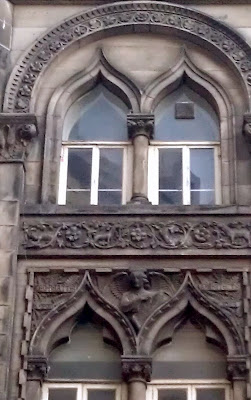In a scaffy corner in the east end of Edinburgh, down the cobbled, dirty-puddled close that is West Register Street, hides a secret treasure: a Venetian Gothic warehouse, built in 1864.
The architect was William Hamilton Beattie, twenty-two years old and still operating under his father's firm's name of George Beattie and Sons. He signed the building, there, look, above the first floor window.
The client was 48-year-old James Cowan (1816-1895), member of a successful family firm of papermakers. I think the portraits on either side of the entrance are of his father Alexander (1775-1859) - whose biography is here - and grandfather Charles (1735-1805).
The Cowans had built a great paper industry in Penicuik to the south of Edinburgh, a spin-off industry from Edinburgh's literary flourishing. They provided the raw material for the Edinburgh Review, Waverley Novels, Blackwoods Magazine and all the rest. During the nineteenth century they prospered, and brought Penicuik with them.
They were also religious and high-minded: idealists who, like today's social entrepreneurs, believed a business could be both profitable for its owners and beneficial for society in a whole range of ways. Alexander had been Presbyterian but James converted to Episcopalianism, perhaps thanks to enthusiasm for Walter Scott, with whom his father was connected; perhaps to enthusiasm for a Gothic aesthetic and the ethical and religious connections with which thinkers like John Ruskin infused it.
Ruskin had written The Stones of Venice ten years earlier, and the Paper Warehouse proclaims that Cowan and Beattie had devoured it. In this work, through a detailed examination of Venetian Gothic architecture, Ruskin argued that the stones themselves testified to a more just, more expressive, more creative society than nineteenth-century industrial Britain. The recreation of the cosmopolitan cusps and corbels of Venetian Gothic in an auld reekie close is a symbol of a dream of a better society.
Every ornament is different. Star, diamond, circle, cross; different species of plant above each first-floor window; a different composition of birds and reptiles above each of the ground-floor ones, where, as John Ruskin pointed out, the richest carving should go to be clearly seen, from the bird catching a snake to the ferns to the squirrel, a lonely mammal.
All the designs are based closely on observation of nature, all express the freedom and individuality of the artist. Above the main entrance, coloured stone adds polychromatic richness, like heraldry or oriental mosaics - somewhere in there, under the grime.
I discovered the building because of an insult. Cowan was Lord Provost of Edinburgh at the time when the competition to build St Mary's Cathedral was being run. The English Church Times was amongst Episcopalians in fits of indignation that city officials who were probably vulgar, provincial, tasteless, and Presbyterian were part of the committee choosing the architect. "The grocer's term of Provostship expired, and his successor, a paper maker, was probably more amenable to reason. Mr Lascelles [Lessels, an Edinburgh architect whose design was inferior] was, happily, relegated to obscurity; and, by a sort of compromise [...] Sir G. G. Scott, the safe architect of the present day, has been chosen". The Church Times could sneer at George Gilbert Scott as much as they liked, but someone wrote in from Edinburgh to defend the papermaker: "The papermaker referred to is an Episcopalian, and member of a firm which has shown some taste and love for architecture in selecting the Venetian Gothic for his place of business". (Church Times, December 1872).
Like all Cowan's business, and like the Episcopal church at the time, it is a beautiful dream of a better society. Next time you are passing the east end of Edinburgh, step out of the crowds, away from the glossy shops, and into the dirty close, and catch the dream.
The young Beattie went on to develop his own style and to reshape Edinburgh: he built Jenners and the Balmoral.
Follow me on twitter @eleanormharris









No comments:
Post a Comment